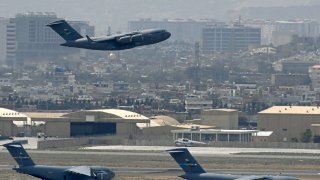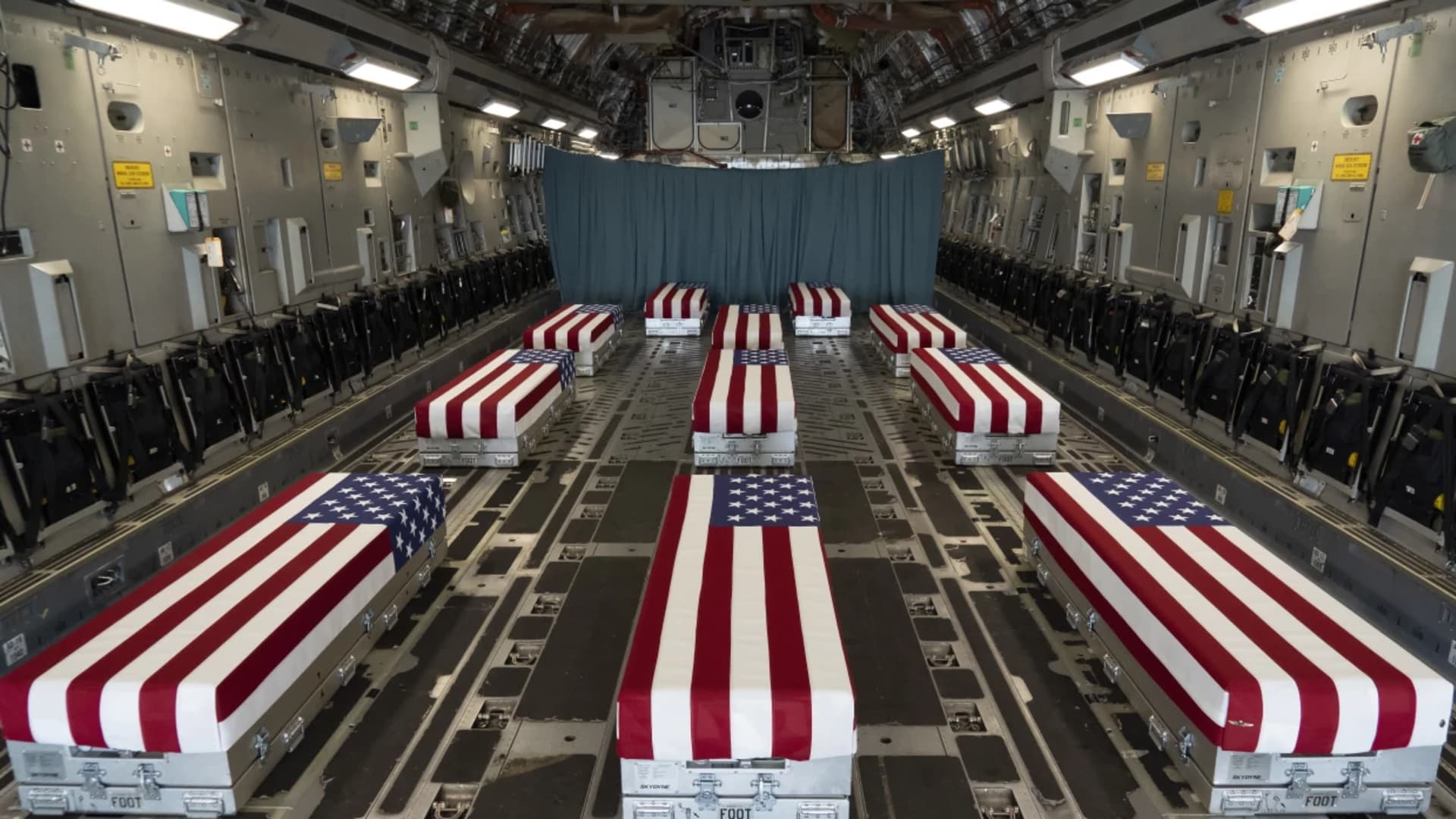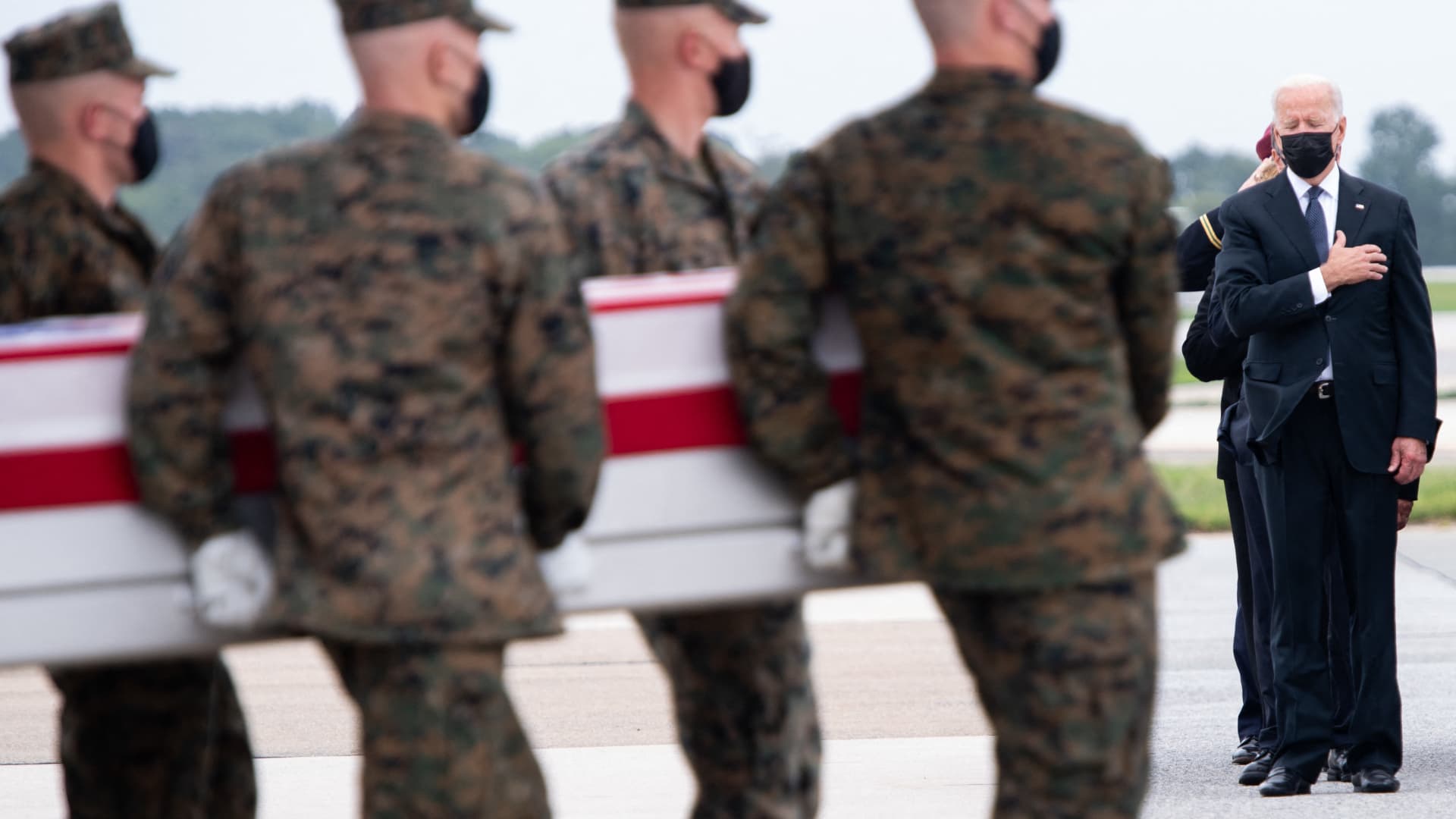
- The United States has finished its evacuation efforts from Kabul's airport, the Pentagon said Monday, effectively ending America's longest war.
- The last C-17 military cargo aircraft departed Hamid Karzai International Airport on Monday afternoon Eastern time.
- Marine Corps General Kenneth McKenzie, commander of U.S. Central Command, said there were no Americans on the last five flights out of Kabul.
- President Joe Biden said he would address the nation Tuesday afternoon.
WASHINGTON — America's longest war is over.
The United States finished its withdrawal efforts from the airport in Kabul, Afghanistan, the Pentagon said Monday, effectively ending a two-decade conflict that began not long after the terrorist attacks of Sept. 11, 2001.
After the Pentagon's announcement, President Joe Biden, in a statement Monday evening, thanked the American military and said he would address the nation Tuesday afternoon about his decision not to prolong the U.S. mission in Afghanistan beyond Aug. 31.
Get top local stories in Connecticut delivered to you every morning. Sign up for NBC Connecticut's News Headlines newsletter.
"The past 17 days have seen our troops execute the largest airlift in U.S. history, evacuating over 120,000 U.S. citizens, citizens of our allies, and Afghan allies of the United States," the president said in the statement.
"They have done it with unmatched courage, professionalism, and resolve. Now, our 20-year military presence in Afghanistan has ended."
In the final week of the withdrawal, terrorists from the group ISIS-K killed 13 U.S. service members and dozens of Afghans in an attack outside the airport. U.S. forces retaliated and launched strikes in a bid to thwart other attacks.
Money Report
The last C-17 military cargo aircraft departed Hamid Karzai International Airport on Monday afternoon Eastern time, according to U.S. Marine Corps General Kenneth McKenzie, commander of U.S. Central Command, completing a massive evacuation effort that flew more than 116,000 people out of Afghanistan over the past two weeks.
McKenzie, who oversees U.S. military operations in the region, said the Taliban did not have direct knowledge of the U.S. military's time of departure, adding that commanders on the ground "chose to keep that information very restricted."
"But they were actually very helpful and useful to us as we closed down operations," McKenzie said of the Taliban.
McKenzie said there were no Americans on the last five flights out of Kabul.
"We were not able to bring any Americans out; that activity probably ended about 12 hours before our exit. Although we continue the outreach and would have been prepared to bring them on until the very last minute, but none of them made it to the airport," McKenzie said.
The four-star general added that there were no evacuees left at the airfield when the last C-17 took off and confirmed that all U.S. service members and troops from the Afghan military force along with their families were also airlifted out on Monday.
Secretary of State Antony Blinken said later on Monday that fewer than 200 Americans are still seeking evacuation.
"Our commitment to them and to all Americans in Afghanistan and everywhere in the world continues. The protection and welfare of Americans abroad remains the State Department's most vital and enduring mission," the nation's top diplomat said in an evening address.
As of early Monday, U.S. and allied forces evacuated 1,200 people out of the Afghan capital on 26 military cargo aircraft flights in a 24-hour period, according to the latest figures from the White House.
About 122,800 people have been evacuated since the end of July, including about 6,000 U.S. citizens and their families.
"A new chapter of America's engagement with Afghanistan has begun. It's one in which we will lead with our diplomacy. The military mission is over. A new diplomatic mission has begun," Blinken said.
Blinken added that the U.S. had suspended its diplomatic presence in Kabul and will transfer those operations to Doha, Qatar.
"We will remain vigilant in monitoring threats ourselves and will maintain robust counterterrorism capabilities in the region to neutralize those threats if necessary — as we demonstrated in the past few days by striking ISIS facilitators and even threats in Afghanistan, and as we do in places around the world where we do not have military forces on the ground," Blinken said.
The Taliban return to power

The U.S. began its war in Afghanistan in October 2001, weeks after the attacks of Sept. 11. The Taliban at the time provided sanctuary to al-Qaeda, the group that planned and carried out the devastating terrorist attacks on the World Trade Center and the Pentagon.
Since then, about 2,500 U.S. service members have died in the conflict, which also claimed the lives of more than 100,000 Afghan troops, police personnel and civilians.
Now the Taliban are yet again in power.
In the final weeks of a planned exodus of foreign forces from Afghanistan, the Taliban carried out a succession of shocking battlefield gains.
The Taliban seized Bagram Air Base, a sprawling and once-stalwart U.S. military installation, less than two months after U.S. commanders transferred it to the Afghan National Security and Defense Force.
In 2012, at its peak, Bagram saw more than 100,000 U.S. troops pass through. It was the largest U.S. military installation in Afghanistan.
As the Taliban moved closer to the capital, Afghan President Ashraf Ghani fled the country, and Western nations rushed to evacuate embassies amid a deteriorating security situation.
Biden ordered the deployment of thousands of U.S. troops to Kabul to help evacuate U.S. Embassy staff and secure the perimeter of the airport.
Meanwhile, thousands of Afghans swarmed the tarmac at the airport desperate to flee Taliban rule.
Despite being vastly outnumbered by the Afghan military, which has long been assisted by U.S. and NATO coalition forces, the Taliban seized the presidential palace in Kabul on Aug. 15.
In April, Biden ordered the full withdrawal of approximately 3,000 U.S. troops from Afghanistan by Sept. 11. He later gave an updated timeline saying the U.S. military mission in Afghanistan will end by Aug. 31.
Following the Taliban takeover, Biden defended his decision that the U.S. would depart the war-torn country.
"I stand squarely behind my decision. After 20 years I've learned the hard way that there was never a good time to withdraw U.S. forces," Biden said a day after Afghanistan collapsed to the Taliban.
"American troops cannot and should not be fighting in a war and dying in a war that Afghan forces are not willing to fight for themselves," Biden said. "We gave them every chance to determine their own future. We could not provide them with the will to fight for that future," he added.
Final U.S. casualties of Afghan war

The Pentagon on Saturday released the names of the 13 U.S. service members killed after a suicide bomber detonated an explosive near the gates of Kabul's airport.
The Aug. 26 attack, which killed 11 Marines, one Navy sailor and one Army soldier, is under investigation.
On Sunday, the president and first lady Jill Biden traveled to Dover Air Force Base to meet privately with the families of the fallen before observing the dignified transfer of American flag-draped caskets from a C-17 military cargo plane to a vehicle.
A dignified transfer is a solemn process in which the remains of fallen service members are carried from an aircraft to a waiting vehicle. It is conducted for every U.S. service member killed in action.
The remains of the service members were flown from Kabul to Kuwait and then to Germany before arriving at Dover.
Sunday marked the first time Biden has attended a dignified transfer since he became president.

Secretary of Defense Lloyd Austin and Chairman of the Joint Chiefs of Staff Mark Milley also attended the dignified transfer, along with U.S. Marine Corps Commandant Gen. David Berger, U.S. Army Chief of Staff Gen. James McConville, Chief of Naval Operations Adm. Michael Gilday and U.S. Air Force Col. Chip Hollinger, who oversaw the military logistics of the transfer.
The fallen include:
Marine Corps Staff Sgt. Darin T. Hoover, 31, of Salt Lake City, Utah
Marine Corps Sgt. Johanny Rosariopichardo, 25, of Lawrence, Massachusetts
Marine Corps Sgt. Nicole L. Gee, 23, of Sacramento, California
Marine Corps Cpl. Hunter Lopez, 22, of Indio, California
Marine Corps Cpl. Daegan W. Page, 23, of Omaha, Nebraska
Marine Corps Cpl. Humberto A. Sanchez, 22, of Logansport, Indiana
Marine Corps Lance Cpl. David L. Espinoza, 20, of Rio Bravo, Texas
Marine Corps Lance Cpl. Jared M. Schmitz, 20, of St. Charles, Missouri
Marine Corps Lance Cpl. Rylee J. McCollum, 20, of Jackson, Wyoming
Marine Corps Lance Cpl. Dylan R. Merola, 20, of Rancho Cucamonga, California
Marine Corps Lance Cpl. Kareem M. Nikoui, 20, of Norco, California
Navy Hospitalman Maxton W. Soviak, 22, of Berlin Heights, Ohio
Army Staff Sgt. Ryan C. Knauss, 23, of Corryton, Tennessee.






